A Comprehensive Guide to Pet Birds: Species, Care, and Enrichment
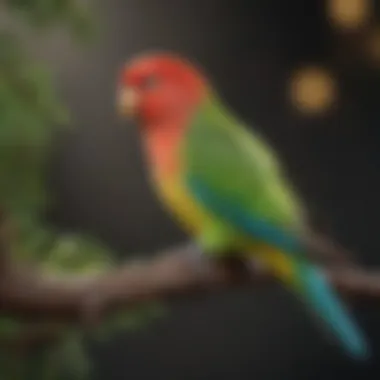
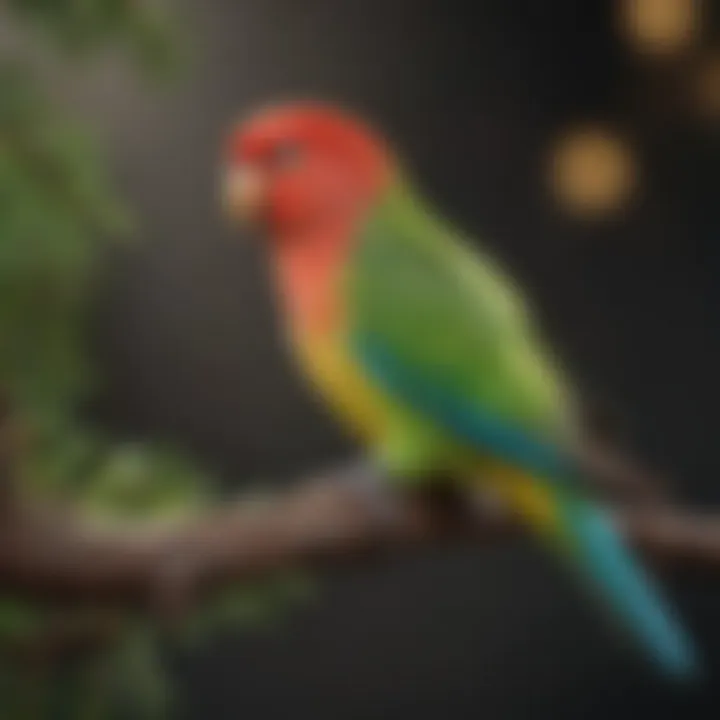
Intro
Caring for pet birds can be both a rewarding and complex experience. These feathered companions can bring joy, companionship, and a sense of liveliness to any home. However, each species comes with its own set of needs and quirks that require attention from their owners. From selecting the right species, like a chirpy budgerigar or a vibrant cockatiel, to understanding their nutritional requirements and behavioral tendencies, a well-rounded approach is essential for fostering a healthy relationship with your avian friend.
This comprehensive guide aims to equip both new and experienced bird owners with vital information. By delving into their unique traits, care instructions, and enrichment necessities, we’ll ensure that every owner is ready to offer a nurturing environment. With proper care, birds can lead happy, healthy lives, becoming joyous additions to our families.
Care Tips
Taking care of a bird isn't a walk in the park; it requires dedication. Here are some essential care tips to keep your feathered friends thriving:
Daily Care Routines
Each day should start with a basic routine. It's important to greet your bird in the morning, allowing them to stretch their wings and enjoy exposure to natural light. Feeding should happen at consistent times. Fresh water and clean food should be prioritized. A quick check for signs of health issues during this routine also helps catch any potential problems early.
Cage Setup and Maintenance
Creating a comfortable living space is crucial. The size and type of cage vary depending on the species. A spacious cage allows for exercise and play, so keep this in mind. Perches, toys, and food dishes should be arranged thoughtfully to encourage natural behaviors.
Maintenance involves regular cleaning—bedding should be replaced, and food and water dishes should be thoroughly cleaned daily to prevent health risks.
Hygiene and Cleaning Practices
Birds are sensitive to their environment. Hygiene is essential. A weekly deep clean of the cage is advisable. Use bird-safe products for cleaning, avoiding any harsh chemicals. Keep an eye out for mold, which is dangerous for birds.
Seasonal Care Adjustments
Bird care changes with the seasons. In summer, ensure they have ample fresh water and shade to escape the heat. In winter, be mindful of drafts and maintain a consistent indoor temperature. Seasonal changes in diet may also be necessary to balance the nutritional needs of your bird.
"A clean and well-maintained space helps your bird feel secure and happy."
Behavioral Insights
Understanding bird behavior is critical for a fulfilling relationship. Here are some insights to help:
Understanding Bird Body Language
Birds communicate much through body language. A relaxed bird will often have their feathers smooth and may make soft chirps. On the other hand, a puffed-up chest can signal stress or illness. Observe carefully to interpret their feelings better.
Common Behavioral Issues and Solutions
Birds may display problematic behaviors, like excessive screaming or feather plucking. Identifying the root cause is key—often, boredom or lack of social interaction is to blame. Providing interactive toys or establishing a routine can mitigate these issues.
Positive Reinforcement Techniques
Rewarding desired behaviors encourages good habits. Offering a treat or verbal praise when your bird does something right fosters trust and strengthens your bond.
Social Interaction Needs
Birds, particularly social species, thrive on interaction. Spending time with your bird daily is essential. They enjoy talking, playing, and sometimes simply being close to you. Consider allowing them supervised time outside the cage to explore safely.
Nutrition Guides
Feeding a bird requires careful planning. Here’s a guide on maintaining a balanced diet:
Essential Diet Components
A well-rounded diet generally includes high-quality pellets, fresh fruits, and vegetables. Consult specific species requirements, as some birds may require more seeds or particular nutrients.
Safe and Toxic Foods
Not everything is safe for birds. Common safe foods include apples, carrots, and spinach. Conversely, avocados and chocolate can be poisonous. Always research and double-check before introducing new foods to their diet.
Supplements and Treats
Occasional treats should enhance, not replace their diet. Millet sprays or specific bird-safe nuts can make them feel rewarded. But moderation is vital.
Feeding Strategies for Different Species
Each bird comes with distinct dietary requirements depending on their species and size. Budgerigars may thrive on a seed-based diet, while larger parrots often need more fruits and vegetables for a balanced intake.
Wellness and Health
Health maintenance goes beyond diet. Here’s a rounded perspective:
Routine Health Checkups
Regular vet visits help catch potential health issues before they escalate. Your vet can guide you regarding vaccinations and other preventative care measures tailored to your bird’s species.
Identifying Symptoms of Illness
Being observant makes a world of different. Weight loss, fluffed feathers, or a change in vocalization can be signs of sickness. If you notice any of these symptoms, a vet appointment is warranted.
Preventative Care and Vaccinations
Can prevent many illnesses through vaccinations and regular wellness checks. An ounce of prevention is often worth a pound of cure in bird care!
Mental and Emotional Well-being
Birds need enrichment for their mental health. Social interactions, regular out-of-cage time, and safe toys greatly benefit their overall well-being.
Enriching Activities
Keep your bird’s mind sharp and body active. Here are activities to consider:
Toys and Playtime Ideas
Investing in various toys—like swings, ladders, and chewable options—keeps birds entertained. Rotate them regularly to maintain interest.
Training and Tricks
Birds are smart; training them can be incredibly rewarding. Teaching simple commands or tricks provides mental stimulation and strengthens your bond.
Outdoor Activities and Interaction
Supervised outdoor time can be thrilling for birds. It’s important to ensure they're safe from predators and that they’re comfortable in their environment.
DIY Projects for Mental Stimulation


Creating homemade toys and puzzles can be a fun project. Simple materials like cardboard boxes make excellent enrichment tools.
By focusing on each aspect of caring for pet birds, we can create a nurturing and fulfilling environment that supports their needs and enriches our lives.
Prelude to Pet Birds
Birds have been captivating human hearts for centuries. Their colorful feathers, joyous songs, and charming personalities make them popular companions in many households. Understanding pet birds is essential for potential owners, as their needs and characteristics vary significantly across different species. This section dives into what makes avian companionship appealing and offers fundamental considerations for anyone thinking about inviting a feathered friend into their life.
The Appeal of Avian Companionship
Birds are not just pets; they are lively companions who bring a unique dynamic to a home. They possess distinct personalities, often more expressive than one might expect. The chirping of a parakeet or the whistling of a cockatiel can brighten any dreary day. Each species exudes its flair, often delivering a burst of color and life into otherwise mundane spaces.
Moreover, pet birds are relatively low-maintenance compared to other pets like dogs or cats. They don’t require daily walks and can often entertain themselves (and their owners) with playful antics. The bond formed between a bird and its owner can be just as fulfilling as that of a traditional pet. A simple interaction, like teaching a bird to speak or sharing a moment of mirth as it dangles from its perch, can fuel deep companionship.
However, one must understand that birds are also unique in their needs and behaviors—beyond simply being cute and colorful. They require mental stimulation, a safe environment, and proper diet. Understanding these needs is key to fostering a long-lasting and healthy relationship. In this light, embarking on the journey of being a bird owner is not just about enjoying their company but also about committing to their welfare and happiness.
Considerations Before Adopting a Bird
Before bringing a bird home, there are several crucial factors to weigh.
- Lifespan: Many pet birds live for a long time. For instance, larger species, like Macaws, can live up to 50 years or more. This lengthy lifespan necessitates a serious long-term commitment.
- Space: Birds need room to flutter around, not just in their cages but also when they are out. It’s essential to assess whether your living arrangements can accommodate a bird’s requirement for a safe flight path.
- Compatibility: Some birds are social while others prefer solitude. It’s essential to match their personality traits with your lifestyle and household dynamics. For example, if you already have pets, you might want to think about how a new bird will mesh with them.
"The joy of avian companionship comes with responsibility. Inform yourself before embarking on this journey to ensure a match that benefits both you and your feathered friend."
- Care and Maintenance: Each bird species has its own dietary needs and healthcare requirements. Understanding what food and medical care is necessary for the bird you choose is critical. This research can avoid health problems later on.
- Noise Levels: Some birds, like Parrots, can vocalize loudly and frequently. If you live in an apartment or have neighbors, consider how well they'll react to the sounds of a feathered friend doing its thing.
By taking these elements into account, prospective bird owners can better prepare for what it means to welcome a pet bird into their lives. This is not just a light-hearted affair, but rather a commitment to nurture and care for an animal that relies on you.
Understanding these factors paves the way for a fruitful relationship with your future avian companion.
Commonly Kept Bird Species
When it comes to finding the perfect feathered friend, understanding the commonly kept bird species is crucial. Each type of pet bird comes with its unique blend of characteristics, behaviors, and care requirements. Knowing what each species demands can make all the difference in fostering a positive relationship between you and your avian companion. This section explores the spectrum of birds that are popular among pet owners, highlighting their unique traits and the considerations needed to give them a nurturing environment.
Parakeets: The Colorful Companions
Characteristics and Temperament
Parakeets, often known as budgerigars or "budgies," are beloved for their vibrant plumage and amiable nature. They typically flaunt bright colors ranging from electric blue to sunny yellow, making them visually appealing pets. Their temperament tends to be playful and sociable, which adds to their charm.
One key characteristic of parakeets is their intelligence. They are quite clever and can mimic sounds and words, which delights many owners. This engaging quality not only entertains but also strengthens the bond between bird and owner. However, it is essential to remember that their social nature means they thrive in environments where they receive regular interaction. Without adequate companionship, they may become bored or even develop behavioral issues.
Socialization Needs
Parakeets, as social creatures, flouris on company, whether it’s from their own kind or their human caretakers. Encouraging socialization is crucial, particularly if you have just one parakeet. Interactive play and regular handling can keep them content, serving both their emotional and physical needs. It's a good practice to spend time talking to them and allowing them to explore their surroundings out of the cage.
Providing a companion bird can significantly enhance their social dynamics, but this also requires understanding their compatibility with other species. Mixing species can sometimes lead to conflicts, so it’s important to research before introducing a new feathered friend into their space.
Health Considerations
Keeping a close eye on parakeets' health is indispensable. These birds can experience a range of health issues, from respiratory infections to diet-related problems. Regular veterinary check-ups can help catch illnesses early and provide important preventive care. Their diet should be balanced, incorporating seeds, pellets, and fresh fruits and vegetables to avoid nutritional deficiencies. Moreover, a well-maintained habitat is vital in reducing exposure to diseases that frequent captive birds.
Cockatiels: Personalities and Care
Unique Traits
Cockatiels are known for their charming personalities and distinctive crest atop their heads. They are affectionate birds that often seek human interaction, making them a popular choice for pet owners. One of their key traits is their ability to bond closely with people; they can develop strong, affectionate relationships with their caretakers.
These birds also exhibit a playful nature, often engaging in antics that amuse their human companions. However, care must be taken to address their need for stimulation and socialization. A bored cockatiel can become destructive or develop undesirable behaviors, which can be a handful for any owner.
Habitat Requirements
Creating an appropriate habitat for cockatiels involves more than just a cage. They need space to move around and stretch their wings. A large cage is a must, preferably one that allows them to climb and explore. Their environment should also include perches of varying thickness to maintain healthy feet and provide mental stimulation.
Temperature is another important aspect. Cockatiels thrive in a moderately warm environment and should be kept away from drafts and direct sunlight. Providing a safe space that also accommodates their need for exploration will ensure they remain happy and healthy.
Nutritional Guide
When it comes to feeding cockatiels, variety is key. A balanced diet typically includes a combination of seeds, pellets, and fresh vegetables. They love leafy greens, and some fruits can be introduced for a treat now and then. However, vigilance is essential, as they can gain weight quickly if indulged too much. Regular dietary adjustments based on their health can help in managing weight and ensuring they receive all necessary nutrients.
Canaries: Melodic Beauties
Types of Canaries
There are numerous types of canaries, each with its unique aesthetic and vocal flair. While some canaries, like the American Singer, are praised for their melodious singing, others might be admired for their stunning colors and feather patterns. This diversity allows prospective bird owners to choose based on their preferences, whether that’s a lively songster or a beautiful breed.
The considerable variation in canary types can also influence their specific care needs, necessitating an informed approach to ownership. For instance, some varieties might require more interaction, while others are more independent.
Care and Maintenance
Canaries are relatively low-maintenance when compared to some other pet birds. This aspect makes them appealing for individuals aspiring to have a pet bird but lacking the time for extensive interaction. However, despite their independent nature, they still need a clean and stimulating environment. Regular cage cleaning is essential to prevent the buildup of waste and promote overall health.
Their dietary requirements include a good mix of seed, fresh greens, and occasional fruits. Attention needs to be paid to ensure their diet is balanced and meets their needs.
Common Health Issues
Like all pet birds, canaries are not immune to health problems. Common issues range from respiratory problems to feather plucking, which can indicate stress or illness. Owners should be on the lookout for symptoms such as changes in appetite, lethargy, or unusual vocalizations. Keeping a close partnership with an avian vet can help navigate any health concerns that may arise during their life.
Lovebirds: Small but Social
Social Dynamics
Lovebirds are tiny but brimming with character. They typically exhibit strong social behaviors and are often described as affectionate. It is essential to appreciate that these birds do best with partners—either another lovebird or ample interaction with their human owner.
Their social dynamics often lead to playful antics, which are delightful to watch. However, solitary lovebirds can be prone to loneliness, leading to behavioral issues like excessive screeching or aggression. Therefore, encouraging interaction forms a significant part of their overall care.
Space and Cage Considerations
Understanding the space needs for lovebirds is crucial. Though smaller than many pet birds, they still require adequate space to fly and explore. The dimensions of the cage should be sufficient to allow them movement without feeling cramped. Additionally, enriching the cage with toys and perches enhances their environment, catering to their natural instincts to play and climb.
It is advisable to regularly rotate their toys and perches to keep their habitat stimulating, helping to avoid boredom and stress.
Behavioral Insights
Lovebirds display intriguing behavioral patterns that are essential for owners to understand. They communicate through vocalizations and body language, showcasing their moods and feelings. Observing changes in this behavior can reveal a lot about their welfare and needs.
Encouraging playful exercises and training routines helps channel their energetic disposition positively. This not only strengthens the bond but also supports their mental health, turning any interaction into a rewarding experience.
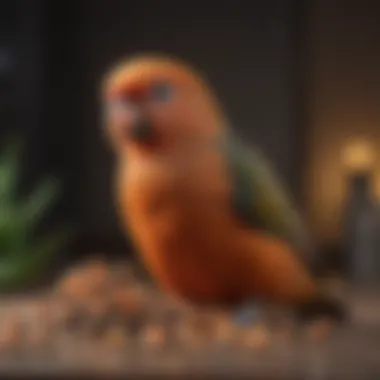
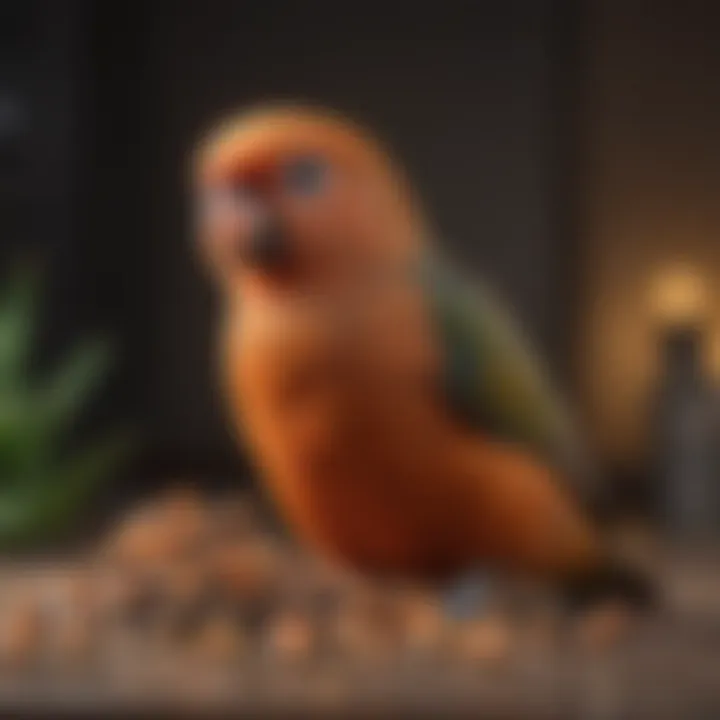
Finches: Birds of Color and Song
Types of Finches
Finches come in various species, each with its distinctive colors and songs, making them a captivating choice for bird lovers. Among the popular types are the Zebra Finch and the Gouldian Finch, known for their striking plumage and lively songs. Each species has its traits and behaviors, which can affect how they interact within a household.
Selecting the right species can add richness to your environment, but considering their social requirements is essential since many finches prefer to be in pairs or small groups.
Behavior and Housing
Finches are generally social birds, thriving in aviaries or groups, where they can engage with one another. Unlike some other bird species, finches don't usually require much direct human interaction, which may suit busy owners. However, they need a roomy enclosure that allows for flight, exploration, and multiple perches to satisfy their natural instincts.
Creating a community amongst finches can be rewarding, but it's also vital that they have space to avoid conflicts.
Feeding Habits
The diet of finches primarily consists of a variety of seeds and grains. It’s advisable to offer a balanced seed mix and supplement their diet with fresh greens and occasional fruits. Keeping their feeding routines consistent can help maintain their health while ensuring they receive diverse nutritional benefits.
In summary, the choice of pet birds varies widely, each species offering distinct features and requirements. Understanding these common bird species can foster enriched relationships and ensure that both pets and owners thrive together.
Setting Up a Bird-Friendly Environment
Creating a bird-friendly environment is more than just a nice cage and some toys. It’s about establishing a delicate balance where your avian companion feels safe, stimulated, and healthy. A thoughtful setup can significantly enhance your bird's quality of life, impacting its behavior, health, and happiness. If you're planning to welcome a feathered friend into your home, it�’s crucial to understand key factors that contribute to an inviting space for them.
When establishing an ideal environment, there are several aspects to keep in mind, such as the right cage, proper location, and temperature considerations. Each of these elements contributes to ensuring your bird thrives in its new setting.
Choosing the Right Cage
Size and Dimensions
When it comes to the size and dimensions of a bird's cage, bigger is often better. Birds need room to spread their wings—literally. A larger cage allows for more movement, exploration, and playtime. The cage should ideally be at least twice the wingspan of your bird to allow for comfortable flight. For example, a cockatiel’s cage should be no less than 24 inches long by 24 inches wide. This size accommodates their desire to flap around and keeps them from becoming bored or stressed.
"A cramped cage leads to a cramped mind."
Having enough space also means you can fit in various toys and perches, which are essential for mental stimulation.
Materials and Safety
Materials play a crucial role in determining how safe a cage is for your bird. Choose cages made from non-toxic metals like stainless steel or powder-coated finishes. Avoid cages that are made from soft metals like lead or zinc, as these can be harmful. Not only should the materials be safe, but they also need to be sturdy enough to withstand your bird's activities. A flimsy cage may not hold up to the energetic nature of pet birds, leading to potential escape or injury.
Wood cages are often aesthetically pleasing, but ensure they are untreated and safe for birds, as some treated woods can release harmful chemicals.
Accessories for Enrichment
Your bird's cage should not look like a barren wasteland. It should resemble a bustling habitat filled with accessories that encourage exploration and mental engagement. Toys like swings, ladders, and mirrors stimulate your bird’s natural instincts and provide hours of entertainment.
Perches should vary in size and texture to promote foot health and exercise. Natural wood perches might be a great addition, giving your bird the chance to climb and explore just as it would in the wild. Remember, a well-equipped cage is a happy cage, directly influencing your bird's well-being and behavior.
Location and Temperature Considerations
Natural Light Requirements
A bright spot in the room can go a long way in enhancing your bird’s mood. Birds thrive in natural sunlight, which helps regulate their circadian rhythms. However, placing the cage near a window can be a double-edged sword. While it provides light, it may also expose your bird to drafts or extreme temperatures. It’s best to situate the cage where it receives natural light but is shielded from direct breezes and sunlight. A gentle balance is key.
Avoiding Hazards
Safety should always be top of mind while choosing the location for your bird's cage. Look for potential hazards, including open flames, toxic plants, or areas where heavy items could fall. Place the cage in an area where your bird can engage with family life but away from busy traffic zones—birds are social but can become stressed in overly active areas.
Furnishing your bird’s environment correctly lays the groundwork for a healthy, fulfilling life. The attention you pay to these details will foster a nurturing space, giving your feathered friend a sense of security and contentment.
Nutrition for Pet Birds
Nutrition for pet birds is a cornerstone for ensuring their health and happiness. Just like humans, birds need a balanced diet to thrive. Proper nutrition can enhance their lifespan, support their immune systems, and foster vibrant feathers. The investment in a comprehensive understanding of nutritional needs can pay dividends in the quality of life for both birds and their owners.
Balanced Diet Guidelines
A well-rounded diet is essential for your feathered companions. Here's a deeper look into some vital components of avian nutrition.
Seeds vs. Pellets
When it comes to bird diets, seeds and pellets are often at the forefront of discussions. Seeds are often seen as a traditional choice; they are colorful and seem appealing to both the birds and their owners. However, it's important to note that a seed-only diet lacks essential vitamins and can lead to obesity and malnutrition over time.
On the other hand, pellets are formulated to provide a balanced nutrient profile. They usually include necessary vitamins and minerals, addressing the shortcomings often found in a seed-based diet. A key characteristic of pellets is consistency; birds don’t have the option to pick and choose their favorites, which helps to prevent selective feeding.
In summary, while seeds can be a tasty treat, pellets are a more beneficial basis for a diet, ensuring that your bird gets the right nutrients without having to guess what they may need.
Incorporating Fresh Foods
Fresh foods are another important aspect of a balanced diet. Fruits and vegetables add vital nutrients and hydration that seeds and pellets simply can’t provide alone.
Crisp veggies like bell peppers and leafy greens are great options. Fruits such as apples and berries not only taste great but also offer antioxidants which can greatly benefit overall health. Including fresh foods encourages the natural foraging behavior in birds, promoting mental stimulation.
However, care must be taken with what is served. Some foods are unsafe for birds, like avocados and onion. Thus, knowing safe options is essential. Overall, incorporating fresh goodies is a terrific way to enrich your bird’s diet and foster good eating habits.
Supplementation Needs
Even with a balanced diet of seeds, pellets, and fresh foods, some birds may require supplementation. For instance, birds that are recovering from illness or are very young might need extra support to ensure they are getting adequate nutrition.
Common supplements include vitamin drops or calcium sources such as cuttlebone. The key feature is that supplements should complement what is being fed rather than replace healthy meals. Over-reliance can lead to more harm than good, so consulting with an avian veterinarian regularly is wise.
In sum, supplementation can provide that extra layer of support for your pet bird but should be used carefully and thoughtfully.
Common Nutritional Deficiencies
Birds can face some common nutritional deficiencies which can be pinpointed to poor diet choices. Here are a few:
- Vitamin A Deficiency: Often results in respiratory problems and poor feather quality. Symptoms might show in dull feathers or difficulty in breathing.
- Calcium Deficiency: Particularly prevalent in female birds, it can lead to issues like egg-binding and bone weakness. Signs can include soft-shelled eggs or a limp appearance.
- Protein Deficiency: Often seen in birds fed primarily seeds. It can lead to poor feather growth and lethargy.
Identifying deficiencies early can make a huge difference. Regular vet check-ups and awareness of your pet's diet will help keep your avian friend healthy and vibrant.
Understanding Bird Behavior
Understanding bird behavior is pivotal for anyone contemplating a life shared with these vibrant creatures. Birds, much like humans, express their feelings and thoughts through various modes of communication. Deciphering this behavior can foster a deeper bond between the owner and their pet, making the experience of bird-keeping more rewarding. Birds are intelligent beings with distinct personalities, and taking the time to understand their behaviors can significantly enhance the quality of life for both parties.
Communication and Vocalization
In the realm of bird behavior, communication stands as a vital avenue for interaction. Birds vocalize for diverse reasons—be it to signal distress, attract a mate, or simply to express joy. Recognizing and interpreting these sounds facilitates a more empathetic environment for the bird, ensuring their needs are met effectively.
Types of Sounds
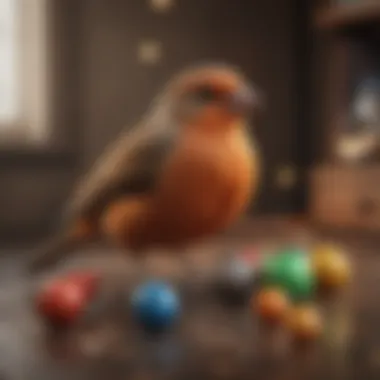
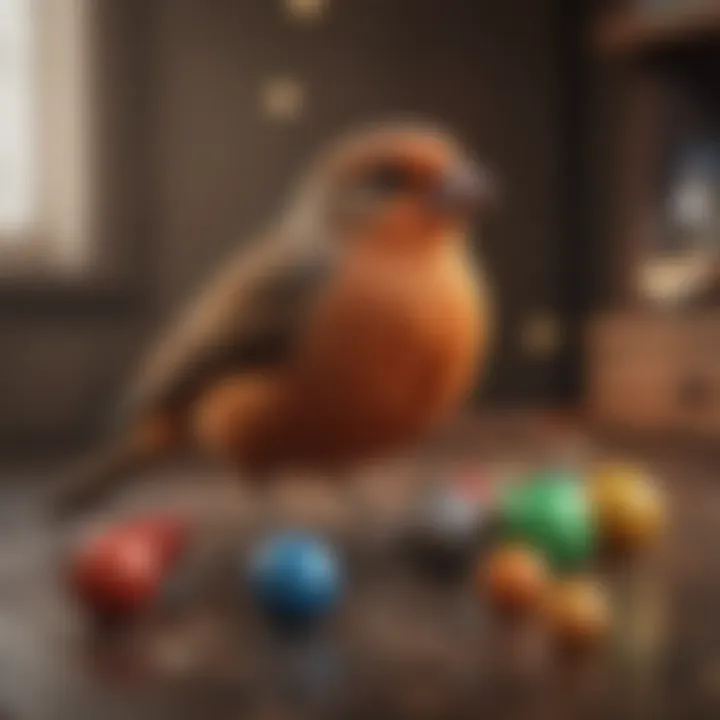
Birds produce a variety of sounds, from melodic chirps to loud squawks. For example, the cheerful notes of a parakeet can convey happiness, while a sharp screech might signal fear or discomfort. Each bird species has its own vocal repertoire, which serves its unique ecological niche.
- Distinctive Calls: Many species like cockatiels have signature calls that resonate with companionship. Understanding these calls can foster affection between the bird and owner.
- Importance of Pitch and Tone: The complexity of sounds, including pitch and tone, helps owners gauge their pet’s emotional state. Low-pitched sounds might signal boredom, while high-pitched sounds often indicate excitement.
- Implications of Vocalization: Recognizing common patterns in vocalization can aid in identifying stressors in their environment or changes in their health status.
Each sound has nuances that contribute to the bird’s overall emotional and psychological state, making the exploration of sound types essential in appreciating avian nuances.
Interpreting Body Language
While sounds are significant, a bird's body language can often communicate even more about their well-being. Body language includes postures, movements, and facial expressions that reveal how birds feel.
- Key Indicators: A relaxed bird with feathers neatly laid flat is usually at ease, while puffed-up feathers can indicate stress or illness. Understanding these signs can preemptively resolve issues before they escalate into serious concerns.
- Behavioral Context: Observing how a bird interacts with its surroundings can also be instructional. For instance, a bird that hides or refuses to engage may be feeling unsafe.
- Facial Expressions: Birds exhibit subtle changes, such as the widening of their eyes, which can indicate surprise or panic. Recognizing these changes strengthens the bond and trust between the bird and owner.
"Understanding the nuances of both sounds and body language paves the way for a more harmonious relationship between pet birds and their owners."
By fostering such awareness, owners not only create a nurturing environment but also cultivate a deeper connection with their avian companions, resulting in proactive and considerate care.
Social Interactions and Bonding
Effective communication goes hand in hand with social interactions, being fundamental for bonding. Birds are inherently social creatures, often thriving in environments that provide opportunities for engagement.
- Creating Connection: Sharing time through play or gentle interaction can establish trust and connection, essential for a happy bird.
- Community Dynamics: Observing how birds interact with each other can provide insight into the social hierarchy, which can be replicated in multi-bird households for a more balanced environment.
- Encouraging Interaction: Activities like taking the bird out of the cage (wearing safety gloves, if needed) and letting them explore can reinforce the notion of trust and companionship.
In summary, understanding bird behavior encompasses a mix of communication skills, keen observation, and social interaction. It’s about embracing the delightful idiosyncrasies of each individual bird, which ultimately leads to a more enriching life for both the pet and the owner.
Health and Wellness for Pet Birds
Maintaining the health and wellness of pet birds is an essential aspect of responsible bird ownership. It encompasses a variety of factors that directly influence a bird's quality of life, longevity, and overall well-being. Understanding health-related issues enhances the bond between an avian companion and its human caregiver, thus fostering a nurturing environment. The significance of focusing on a bird’s health cannot be overstated; proactive measures can prevent minor issues from spiraling into serious concerns, ensuring a long and fulfilling life for these feathered friends.
Routine Health Checks
Routine health checks are vital for identifying potential health issues before they escalate. Regular examinations can spotlight early signs of illness, which is crucial given how subtly birds often display discomfort or sickness.
Identifying Signs of Illness
Identifying signs of illness in birds can be a game-changer in pet bird care. Common indicators include changes in eating habits, droppings, feather condition, or behavior as well. For instance, a sudden decrease in activity level or a bird sitting puffed up may signal sick bird, indicating it's time for a vet visit. Keeping a close eye on these subtle warning signs not only ensures early detection but can also prevent the spread of illness if there are multiple birds in your home. A vital characteristic of effective illness identification is observation.
Here’s what to look for:
- Changes in appetite
- Uncharacteristic vocalization
- Abnormal droppings or discharge
Taking time to study a bird’s usual habits can make it easier to spot something amiss.
Preventive Care
Preventive care is another cornerstone of avian health, encompassing a range of practices that ward off illnesses before they can establish themselves. This involves routine check-ups at the veterinarian, proper nutrition, and a clean living environment for the bird. Ensuring your pet bird is protected from common health risks can save you distress and expenses down the line.
For preventive care, consider the following:
- Regular vet visits: Annual check-ups help in early detection of potential disorders or illnesses.
- Proper diet: A balanced diet reduces the risk of nutritional deficiencies which can lead to health problems.
- Clean environment: Regular cleaning of cages prevents the buildup of bacteria or fungi that can cause diseases.
Regular preventive measures not only lower the likelihood of illness but also lead to a happier, more active bird.
Understanding Common Ailments
Every bird species is susceptible to specific health ailments that can affect their well-being. Familiarizing oneself with common health issues is crucial for timely intervention. Conditions like feather plucking, psittacosis, or even respiratory infections can occur if proper care isn’t taken. Recognizing symptoms and having a basic understanding of these common ailments relates directly back to a bird's wellness. Engaging in dialogue with veterinarians or avian specialists can provide additional insights.
Enrichment Activities for Birds
Creating a fulfilling environment for pet birds goes beyond just providing food and shelter. Enrichment activities are crucial for birds' overall well-being, promoting mental stimulation, physical exercise, and social interaction. These activities help mimic the natural behaviors of birds in the wild, reducing stress and boredom, which can lead to behavioral issues. Understanding this integral aspect of avian care allows caretakers to foster a more engaging and joyful life for their feathered companions.
Toys and Playtime
Types of Toys
Birds are naturally curious creatures; this curiosity can be harnessed through an array of toys.
- Chewable Toys: Made from natural materials like wood, these toys provide a physical outlet for beak maintenance while also satisfying your bird's instinct to gnaw. Birds can easily wear down their beaks through proper chewing, keeping them healthy and trimmed.
- Interactive and Puzzle Toys: These engage a bird's problem-solving skills, encouraging them to figure out ways to obtain hidden treats. They cater to their intelligence and can stave off boredom.
- Foraging Toys: Designed to simulate the search for food in the wild, they encourage birds to explore and search, tapping into their instincts. Birds often enjoy the challenge of discovering a hidden treat.
Keeping a mix of these types of toys is a great way to provide mental and physical stimulation.
Interactive Play Benefits
Interactive play is another essential element for enriching a bird's life. This type of play encourages bonding between the bird and its owner while also promoting physical health. Engaging in activities like play fetch with a ball or teaching tricks can be incredibly stimulating.
- Strengthening Bonds: Engaging in play time helps foster trust and companionship. Birds that play with their owners often form deeper connections and are more confident in their surroundings.
- Exercise and Activity: Many birds don't get enough physical exercise within their cages. Interactive play provides an outlet for movement and helps prevent obesity, a common concern among pet birds.
- Mental Stimulation: Exploratory games challenge your bird's mind, providing a vital area of enrichment.
Training and Mental Stimulation
Basic Training Techniques
Before diving into complex training methods, establishing basic techniques is crucial. Simple commands like "step up" or "stay" can greatly enhance communication between the bird and owner. Training isn't just for show; it's a critical part of social interaction.
- Positive Reinforcement: This technique involves rewarding birds with treats, praise, or affection when they display desired behaviors. It makes learning enjoyable and encourages birds to participate.
- Consistency is Key: Implementing a consistent approach helps birds understand and anticipate expected behaviors.
- Short Sessions: Keeping training sessions brief, roughly 5 to 10 minutes, is more effective for maintaining a bird's attention span.
Challenges for Cognitive Engagement
While training and enrichment can provide significant benefits, challenges also exist that may hinder cognitive stimulation. It’s essential for owners to be aware of these.
- Familiarity Breeds Boredom: Repetitive activities can lead to disinterest. Rotating toys and changing up routines can help keep things fresh.
- Lack of Challenge: If activities are too easy, birds can lose interest. Owners should offer gradual increases in difficulty to keep their birds challenged.
- Social Needs: Some birds thrive on interaction with other birds. When they lack this social engagement, it can often lead to boredom, so considering a companion bird might be worth exploring.
Engaging pet birds in varied activities not only enriches their lives but also offers owners a chance to enjoy the unique personalities of their avian friends. Keeping this at the forefront of bird care ensures that these beautiful creatures lead happy, fulfilling lives.
End: Fostering a Healthy Avian Environment
Creating a healthy environment for pet birds is not just a simple task; it’s about providing a space where their physical and emotional needs are met. This conclusion serves as a crucial reminder of the major aspects discussed throughout the guide, emphasizing the joint responsibilities of care and engagement that every bird owner should prioritize.
Healthy living conditions lead to happier birds, which translates to improved behavior, better health, and a more thriving companionship. Moreover, a well-maintained environment helps to prevent common health issues, promoting longevity in pet birds. For instance, proper cage setup, modest temperature ranges, and clean living spaces minimize stress and illness, bolstering the overall wellbeing of these feathered companions.
Taking into account the insights on nutrition, social interactions, and regular health check-ups sheds light on how interconnected these components truly are. When seen as part of a comprehensive system, it’s evident that careful observation and diligent maintenance form the backbone of avian care. Effective bird keeping encompasses daily routines and environmental factors that should be tailored specifically to the unique needs of each bird species.
Successful bird keeping hinges on creating a nurturing atmosphere that honors the needs of these captivating creatures.
In essence, fostering a healthy avian environment is a blend of compassion, science, and dedication that ultimately transforms the relationship between birds and their human counterparts.
Recap of Key Points
As we wrap up, here are the cornerstone points highlighted throughout the article:
- Diverse Species Needs: Each bird type, from parakeets to cockatiels, brings distinct characteristics that require tailored care.
- Vigilant Health Monitoring: Regular health checks can uncover potential problems before they escalate, ensuring birds remain healthy and vibrant.
- Environmental Enrichment: Toys, mental stimulation, and appropriate social interactions vastly improve the quality of life for pet birds.
- Balanced Nutrition: Understanding dietary requirements, including the importance of seeds, pellets, and fresh foods, is vital for avian health.
Encouragement for Responsible Bird Keeping
The idea of responsible bird keeping stresses the significance of commitment and knowledge in nurturing a pet bird. Consider these key takeaways:
- Inform Yourself: Keep learning; understanding the needs of your bird will guide your actions as a competent owner. Resources such as books, websites like Wikipedia or forums such as Reddit can be invaluable.
- Focus on Quality of Life: The goal should always be to enhance the well-being of your bird, which translates into joyful and enriching experiences for both you and your feathered friend.
- Advocate for Welfare: Promote responsible practices in your community, encouraging others to adopt such standards as they bring home their own avian companions.















